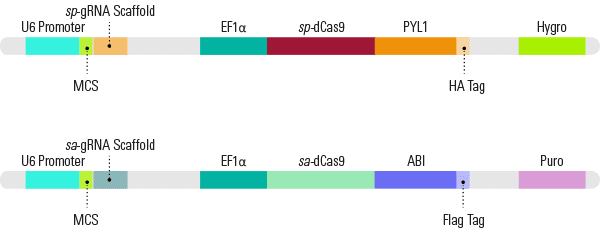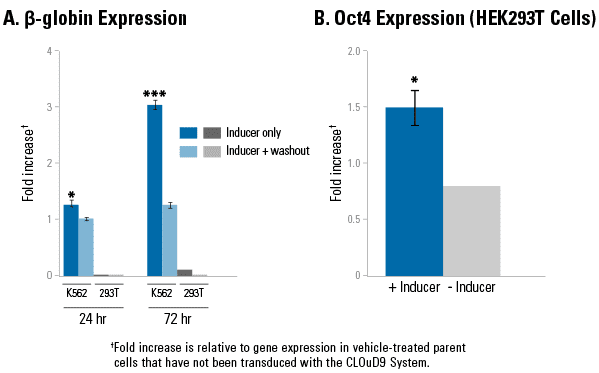CLOuD9 Gene Expression Regulation Kit
- Innovative—leverage the simplicity of CRISPR/Cas9 targeting—free of DNA cleavage activity—for inducible and reversible chromatin loop formation anywhere in the genome
- Well-validated—chromatin loop formation and the resulting changes in gene expression across multiple loci and cell lines is amply demonstrated in Morgan, et al,1
- Broadly applicable—great for studying the role of chromatin in the control of gene expression in a range of areas, including:
- Developmental biology
- Cancer biology
- Chromatin structural biology
- Chromatin-based therapeutic strategies
Products
| Catalog Number | Description | Size | Price | Quantity | Add to Cart | |||
|---|---|---|---|---|---|---|---|---|
| CASCL9-100A-KIT | CLOuD9 Gene Expression Regulation Kit (includes 10 µg each of dCas9-PYL1 and dCas9-ABI1 lentivectors, and 50 µL of 1000x Inducer Agent) | 1 Kit | $1099 |
|
||||
Overview
Overview
Explore a new frontier in the study of gene expression regulationAvailable only from SBI and featured in a recent Nature Communications article1, our CLOuD9 Gene Expression Regulation Kit gives you an exciting and innovative tool for studying—and potentially controlling—gene expression regulation by putting you in control of chromatin loop formation. Gain a clearer understanding of the dynamic effects of chromatin restructuring on the expression of your gene-of-interest and increase gene expression in certain cellular contexts. Combining the simplicity of CRISPR/Cas9 targeting—free from DNA cleavage activity—with inducible and reversible protein dimerization partners, the CLOuD9 Gene Expression Regulation Kit adds a new dimension to your gene regulation studies.
CLOuD9 for Chromatin Loop Reorganization using CRISPR-dCas9:
- Innovative—leverage the simplicity of CRISPR/Cas9 targeting—free of DNA cleavage activity—for inducible and reversible chromatin loop formation anywhere in the genome
- Well-validated—chromatin loop formation and the resulting changes in gene expression across multiple loci and cell lines is amply demonstrated in Morgan, et al,1
- Broadly applicable—great for studying the role of chromatin in the control of gene expression in a range of areas, including:
- Developmental biology
- Cancer biology
- Chromatin structural biology
- Chromatin-based therapeutic strategies
- Unique—the innovative CLOuD9 System is only sold by SBI
- One lentivector plasmid expressing a null Staphylococcus aureus Cas9 protein fused to one of the protein dimerization partners—the ABI protein from the plant abscisic acid (ABA) signaling pathway
- A second lentivector plasmid expressing a null S. pyogenes Cas9 protein fused to the other protein dimerization partner—the PYL1 protein from the plant ABA signaling pathway
 References
References
- Morgan, SL, et al. Manipulation of nuclear architecture through CRISPR-mediated chromosomal looping. Nat Commun. 2017. Jul 13; 8:15993. PMCID: PMC5511349.
References
How It Works
How It Works
Form chromatin loops with CLOuD9
Figure 1. The CLOuD9 System enables formation of inducible and reversible chromatin loops anywhere in the genome.
The CLOuD9 System consists of three components (Figure 1):
- A null mutant of the Cas9 protein from aureus fused to the plant ABI protein
- A null mutant of the Cas9 protein from pylogenes fused to the plant PYL1 protein
- Inducer reagent, the plant phytohormone S-(+)-abscisic acid (ABA)
The use of the Cas9 null mutants enables accurate binding to a specific region of the genome via the user-designed guide RNA (gRNA) without generating any breaks in the DNA. Because the gRNA scaffolds from the two species bind more efficiently to their same-species Cas9 partner, we can direct the saCas9-ABI fusion localizes to one region of the DNA and the spCas9-PYL1 fusion to a second region of DNA.
The dimerization partners—ABI and PYL1—are part of the plant ABA signaling pathway, and form heterodimers in the presence of ABA. Dimerization of ABI and PYL1 is reversible, enabling formation of chromatin loops in the presence of ABA, and disassembly of the chromatin loops upon ABA washout.
Supporting Data
Supporting Data
Study the role of chromatin structure in gene expression
Figure 2. CLOuD9-induced chromatin loops increase gene expression in a context-dependent manner.
1. A CLOuD9-induced chromatin loop at the β-globin locus leads to activation of gene expression in K562 cells but not in HEK293T cells, highlighting the importance of cellular context and the need for additional factors in gene expression. Inducer reagent (in DMSO) was added for either 24-hours or 72-hours. At the indicated time, cells in the “inducer only” treatment group were harvested and analyzed for gene expression, whereas cells in the “inducer + washout” treatment group were washed and then allowed to grow another 24- or 72-hours as indicated in the absence of inducer. Significance assessed relative to DMSO-treated control cells which were not transduced with the CLOuD9 System. * indicates P < 0.05, *** indicates P < 0.0001.
2. Unlike the β-globin locus, a CLOuD9-induced chromatin loop (treated with Inducer Reagent in DMSO) results in robust expression of the Oct4 gene in CLOud9/HEK293T cells compared to CLOuD9/HEK293T cells treated with DMSO only. The CLOuD9 System fusion proteins were targeted to the Oct4 promoter and the 5’ distal enhancer region upstream of the Oct4 promoter. *indicates P < 0.05.
FAQs
Documentation
Citations
Related Products
Products
| Catalog Number | Description | Size | Price | Quantity | Add to Cart | |||
|---|---|---|---|---|---|---|---|---|
| CASCL9-100A-KIT | CLOuD9 Gene Expression Regulation Kit (includes 10 µg each of dCas9-PYL1 and dCas9-ABI1 lentivectors, and 50 µL of 1000x Inducer Agent) | 1 Kit | $1099 |
|
||||
Overview
Overview
Explore a new frontier in the study of gene expression regulationAvailable only from SBI and featured in a recent Nature Communications article1, our CLOuD9 Gene Expression Regulation Kit gives you an exciting and innovative tool for studying—and potentially controlling—gene expression regulation by putting you in control of chromatin loop formation. Gain a clearer understanding of the dynamic effects of chromatin restructuring on the expression of your gene-of-interest and increase gene expression in certain cellular contexts. Combining the simplicity of CRISPR/Cas9 targeting—free from DNA cleavage activity—with inducible and reversible protein dimerization partners, the CLOuD9 Gene Expression Regulation Kit adds a new dimension to your gene regulation studies.
CLOuD9 for Chromatin Loop Reorganization using CRISPR-dCas9:
- Innovative—leverage the simplicity of CRISPR/Cas9 targeting—free of DNA cleavage activity—for inducible and reversible chromatin loop formation anywhere in the genome
- Well-validated—chromatin loop formation and the resulting changes in gene expression across multiple loci and cell lines is amply demonstrated in Morgan, et al,1
- Broadly applicable—great for studying the role of chromatin in the control of gene expression in a range of areas, including:
- Developmental biology
- Cancer biology
- Chromatin structural biology
- Chromatin-based therapeutic strategies
- Unique—the innovative CLOuD9 System is only sold by SBI
- One lentivector plasmid expressing a null Staphylococcus aureus Cas9 protein fused to one of the protein dimerization partners—the ABI protein from the plant abscisic acid (ABA) signaling pathway
- A second lentivector plasmid expressing a null S. pyogenes Cas9 protein fused to the other protein dimerization partner—the PYL1 protein from the plant ABA signaling pathway
 References
References
- Morgan, SL, et al. Manipulation of nuclear architecture through CRISPR-mediated chromosomal looping. Nat Commun. 2017. Jul 13; 8:15993. PMCID: PMC5511349.
References
How It Works
How It Works
Form chromatin loops with CLOuD9
Figure 1. The CLOuD9 System enables formation of inducible and reversible chromatin loops anywhere in the genome.
The CLOuD9 System consists of three components (Figure 1):
- A null mutant of the Cas9 protein from aureus fused to the plant ABI protein
- A null mutant of the Cas9 protein from pylogenes fused to the plant PYL1 protein
- Inducer reagent, the plant phytohormone S-(+)-abscisic acid (ABA)
The use of the Cas9 null mutants enables accurate binding to a specific region of the genome via the user-designed guide RNA (gRNA) without generating any breaks in the DNA. Because the gRNA scaffolds from the two species bind more efficiently to their same-species Cas9 partner, we can direct the saCas9-ABI fusion localizes to one region of the DNA and the spCas9-PYL1 fusion to a second region of DNA.
The dimerization partners—ABI and PYL1—are part of the plant ABA signaling pathway, and form heterodimers in the presence of ABA. Dimerization of ABI and PYL1 is reversible, enabling formation of chromatin loops in the presence of ABA, and disassembly of the chromatin loops upon ABA washout.
Supporting Data
Supporting Data
Study the role of chromatin structure in gene expression
Figure 2. CLOuD9-induced chromatin loops increase gene expression in a context-dependent manner.
1. A CLOuD9-induced chromatin loop at the β-globin locus leads to activation of gene expression in K562 cells but not in HEK293T cells, highlighting the importance of cellular context and the need for additional factors in gene expression. Inducer reagent (in DMSO) was added for either 24-hours or 72-hours. At the indicated time, cells in the “inducer only” treatment group were harvested and analyzed for gene expression, whereas cells in the “inducer + washout” treatment group were washed and then allowed to grow another 24- or 72-hours as indicated in the absence of inducer. Significance assessed relative to DMSO-treated control cells which were not transduced with the CLOuD9 System. * indicates P < 0.05, *** indicates P < 0.0001.
2. Unlike the β-globin locus, a CLOuD9-induced chromatin loop (treated with Inducer Reagent in DMSO) results in robust expression of the Oct4 gene in CLOud9/HEK293T cells compared to CLOuD9/HEK293T cells treated with DMSO only. The CLOuD9 System fusion proteins were targeted to the Oct4 promoter and the 5’ distal enhancer region upstream of the Oct4 promoter. *indicates P < 0.05.



